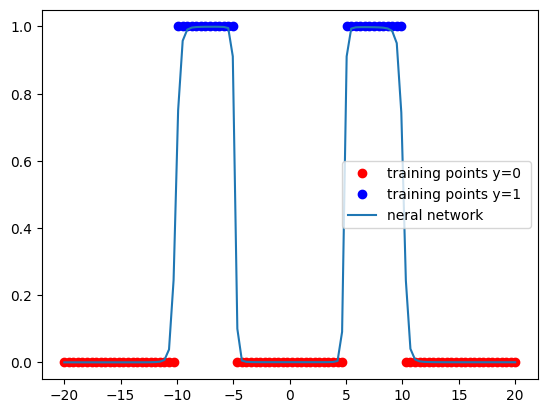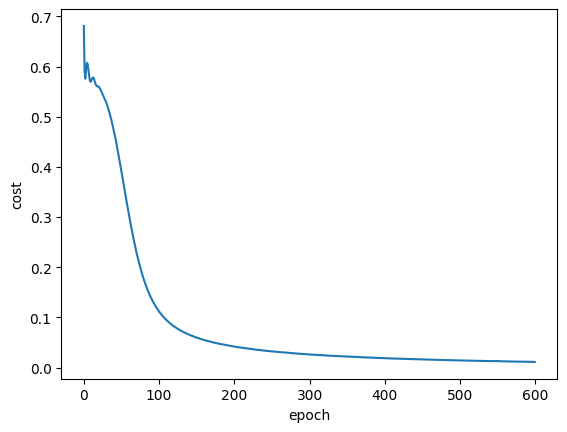import torch
import numpy as np
import matplotlib.pyplot as plt
import torch.nn as nn
import torch.nn.functional as F
from torch.utils.data import Dataset, DataLoaderSoftmax Classifer 1D
How to create complex Neural Network in pytorch.
Keywords
Training Two Parameter, Mini-Batch Gradient Decent, Training Two Parameter Mini-Batch Gradient Decent

Objective
- How to create complex Neural Network in pytorch.
Table of Contents
Estimated Time Needed: 25 min
Preparation
We’ll need to import the following libraries for this lab.
Define the plotting functions.
def get_hist(model,data_set):
activations=model.activation(data_set.x)
for i,activation in enumerate(activations):
plt.hist(activation.numpy(),4,density=True)
plt.title("Activation layer " + str(i+1))
plt.xlabel("Activation")
plt.xlabel("Activation")
plt.legend()
plt.show()def PlotStuff(X,Y,model=None,leg=False):
plt.plot(X[Y==0].numpy(),Y[Y==0].numpy(),'or',label='training points y=0 ' )
plt.plot(X[Y==1].numpy(),Y[Y==1].numpy(),'ob',label='training points y=1 ' )
if model!=None:
plt.plot(X.numpy(),model(X).detach().numpy(),label='neral network ')
plt.legend()
plt.show()Get Our Data
Define the class to get our dataset.
class Data(Dataset):
def __init__(self):
self.x=torch.linspace(-20, 20, 100).view(-1,1)
self.y=torch.zeros(self.x.shape[0])
self.y[(self.x[:,0]>-10)& (self.x[:,0]<-5)]=1
self.y[(self.x[:,0]>5)& (self.x[:,0]<10)]=1
self.y=self.y.view(-1,1)
self.len=self.x.shape[0]
def __getitem__(self,index):
return self.x[index],self.y[index]
def __len__(self):
return self.lenDefine the Neural Network, Optimizer and Train the Model
Define the class for creating our model.
class Net(nn.Module):
def __init__(self,D_in,H,D_out):
super(Net,self).__init__()
self.linear1=nn.Linear(D_in,H)
self.linear2=nn.Linear(H,D_out)
def forward(self,x):
x=torch.sigmoid(self.linear1(x))
x=torch.sigmoid(self.linear2(x))
return xCreate the function to train our model, which accumulate lost for each iteration to obtain the cost.
def train(data_set,model,criterion, train_loader, optimizer, epochs=5,plot_number=10):
cost=[]
for epoch in range(epochs):
total=0
for x,y in train_loader:
optimizer.zero_grad()
yhat=model(x)
loss=criterion(yhat,y)
optimizer.zero_grad()
loss.backward()
optimizer.step()
total+=loss.item()
if epoch%plot_number==0:
PlotStuff(data_set.x,data_set.y,model)
cost.append(total)
plt.figure()
plt.plot(cost)
plt.xlabel('epoch')
plt.ylabel('cost')
plt.show()
return costdata_set=Data()PlotStuff(data_set.x,data_set.y,leg=False)
Create our model with 9 neurons in the hidden layer. And then create a BCE loss and an Adam optimizer.
torch.manual_seed(0)
model=Net(1,9,1)
learning_rate=0.1
criterion=nn.BCELoss()
optimizer=torch.optim.Adam(model.parameters(), lr=learning_rate)
train_loader=DataLoader(dataset=data_set,batch_size=100)
COST=train(data_set,model,criterion, train_loader, optimizer, epochs=600,plot_number=200)



this is for exercises
model= torch.nn.Sequential( torch.nn.Linear(1, 6), torch.nn.Sigmoid(), torch.nn.Linear(6,1), torch.nn.Sigmoid()
)
plt.plot(COST)